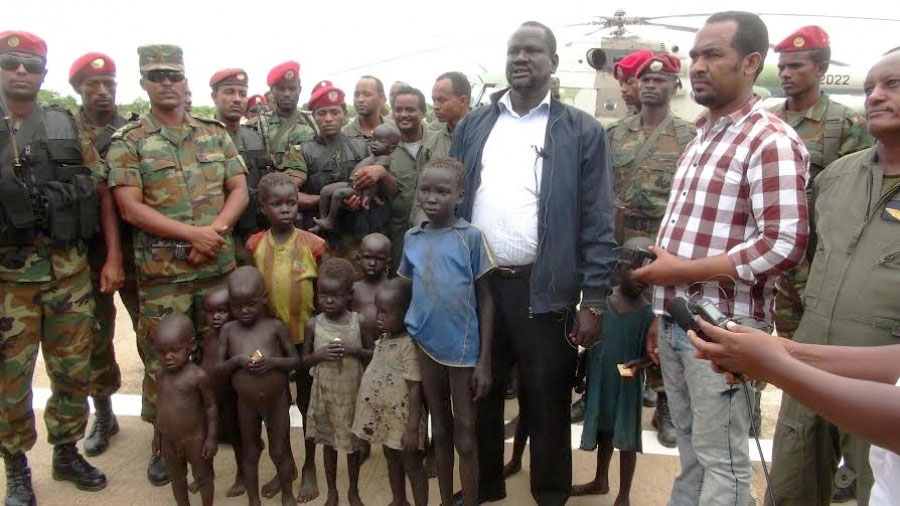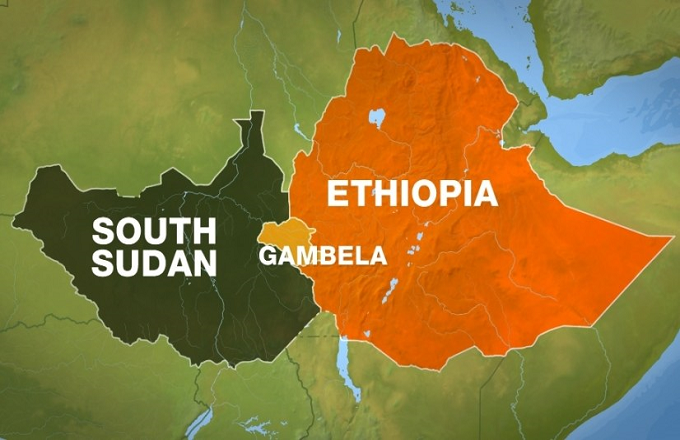Identifying the Causes and Implications of Murle Child Abduction Practice, and its Impacts on Children: A Case Study on Ethiopia's Gambella Region and South Sudan Border

Table of Contents
- Introduction
- The Ethiopia and South Sudan border features
- The Murle groups and “Age-Set" scheme
- The causes of the Murle Cross-Border Child Abductions practice
- Impacts and Implications of Murle's cross-border child abduction practice
- Conclusion
Introduction
The aim of the study is to investigate the causes and impacts of Murle's cross-border child abduction practice and its impact on children in Ethiopia's Gambella region.
Children are defined as those who have not reached the age of majority, or any person under the age of 18 (UNCRC Article 1, Part 1:1989). Over one-third of the world's population consists of children (AI, 2021), with over 400 million children estimated on the African continent (Morosini, M., 2022). According to UNICEF, Ethiopia's population is primarily composed of children, with an average age of 17.9 years. Regardless of any dividing factors, all children possess rights without discrimination.
Moreover, for the development of a child, the enjoyment of rights necessitates human rights commitments. As Freeman(2007) affirms, the"right to have rights" is one of the most fundamental rights for one to begin developing. As a result, many nations developed laws encompassing children's rights.
The Federal Democratic Republic of Ethiopia's (FDRE) constitution, the country's supreme law, contains existing subsidiary laws that embody children's rights. Indeed, Ethiopia has ratified most international and regional human rights instruments that protect children's rights. By ratifying the CRC in 1991, the country incorporated it into its laws via national legislation.
Despite positive progress toward ratification, implementation seems to be remaining insufficient. Conflicts and lack of protection still deprive children of their rights at different points in their lives. For most borderline Ethiopian children, violence and “cross-border child abduction" are among the core challenges to their safe growing environment.
According to studies, child abduction is the act of taking children away "by force or by fraudulent persuasion” (Shutt et al., 2004). It is considered an "unlawful forcible abduction or detention" of children or groups of children in order to extort an economic or political advantage from the victim of the abduction or a third party (Steverson et al.,2021). This practice usually happens without authorization from the child's guardians or laws.
The Ethiopia and South Sudan border features

Figure1: Gambella Map (Aljazeera Media Network)
Ethiopia and South Sudan are two East African countries that share an 874 km (543 miles) border along Ethiopia's Gambella region and Upper Nile and Jonglei state in South Sudan. The Akobo and Baro rivers form the natural border. Nuer, Anywaa, and Murle tribes are all Nilotic ethnic groups inhabiting each bordering corridor within these two African nations (Gashaw, 2017). These ethnic groups share similar socio-cultural features.
In addition to the sociocultural features, there are shared stories about security and human rights issues with both countries struggling to maintain order. For a long period, Gambella's borders were a major route for refugees fleeing the Sudanese "civil war" during both the first (1955-1972) and second (1983-2005) conflicts (Johnson, D. 2016). It should be recalled that thousands of Sudanese "unaccompanied minors" were among those who crossed the border and sought refuge in the Gambella refugee camps (Lijnders, 2013; p.85).
Not only the influx of refugees was so critical. Rather, these regional borders were considered hotbeds of “proxy wars" (Assal, M. et al. 2019; p.175) characterized by mutual support of insurgent movements. Among the insurgency is one of the most recently feared groups, the "Yau Yau Rebels" known as the "Cobra faction” (Jamestown Foundation & McGregor, 2012), originating from the Pibor district of South Sudan’s Jonglei State on the border with Ethiopia. Their activities present mistrust, linked by a situation which makes cross-border movement monitoring challenging. This resulted in child abduction issues for communities living along the borders.
Between 2014 and 2022, child abductions have surged. The raid on "13 Ethiopian Nuer villages" in April 2016, which witnessed the abduction of over 200 children each day (BBC & Al Jazeera, 2016), stands out as one of the most distressing incidents. The most recent cross-border raid occurred in August 2022, and the trend worsens with every dry season. These practices seem to undermine Ethiopia's commitment to children's rights. Despite domesticating relevant child rights instruments, concerns have been raised about their implementation due to raids and abductions in border villages.
The Murle groups and “Age-Set" scheme
Murle is an ethnic group that lives primarily in Boma and Pibor in the Greater Pibor Administrative Area (GPAA), a region in the southeast of the Jonglei State in South Sudan. They exhibit certain pastoralist social norms, including a socially constructed "Age-Set" system (Da Costa,2018). The age sets, or generational groupings, based loosely on age, are integral to their society and serve multiple social functions. Typically, a man will belong to an age set for his entire life, with young men rising to prominence within their respective age sets based on their bravery and abilities.
Similar to their pastoralist counterparts, the Murle ethnic group has a way of life that is centered around cattle. They possess livestock as a means of subsistence and offer it as dowry. In their culture, young women are seen as valuable family assets, and they usually aspire to marry to provide their parents with dowries. As a norm, a man can only wed after paying a considerable amount of cows as dowry. The escalating inflation of bride prices, which is rooted in their cattle-oriented lifestyle, exacerbates the search for more dowries or alternatives. This longing, at any point, has the potential to push most Murle youth members to engage in the act of abduction and village raids. These societal norms have triggered a cycle of retaliatory actions between the young generation of Murle society and their neighboring counterparts.
The causes of the Murle Cross-Border Child Abductions practice
Murle's child abduction practice spread rapidly, but its origins and causes remain obscure. The study findings were based on traditional century-old cultural perceptions of wealth and large families' demands. It is claimed that the practice began decades ago as a non-commercial free adoption of "Dinka'' children who were rejected by their families, simply because they were "born out of wedlock." They are then adopted by childless Murle families, who accept them for adoption. It is believed that non-commercial adoption eventually evolved into cow exchange. As a result of the lack of livestock for exchanges, a number of youth from the aged-set lineages took and abducted children from neighboring communities. The hunt for children continues willingly.
A number of causes are at play, including political marginalization, socio-cultural values and perceptions, and border openness. Socio-culturally, this refers to traditional pressure on brides wealth. Another motive for socio-cultural values is the “abduction of a child for forceful adoption”. Families without boys or children are said to adopt this kind of kidnapped child.
Furthermore, the border between Ethiopia and South Sudan is widely open, allowing easy access, trafficking and the smuggling of harmful tools and people. In recent years, it has been revealed that firearms used for local violence may be transported through unlicensed contraband, typically purchased with cash or cows. Different informal smuggling routes were used to transport contraband. The first route is Dimma Wareda's Bouy-Lulwaro Kebelle (village) to Puchalla South Sudan. On the second route, it is said to be "Burebey village in Wanthoa Wareda, Tierguol in Akobo, and Pagak in Lare Wareda are places where arms dealers camp at informal entry points. Dealers do this because arms are considered endearing for self-defense, income generation, and raiding in pastoralist communities near the border."
Impacts and Implications of Murle's cross-border child abduction practice
Armed groups abducted children crossing the border from South Sudan to Ethiopia led to consequences. These consequences include loss of life, the disappearance of children, livestock losses, disruption of schooling and economic activities that benefit children, as well as displacement and separation from family (Berhane, 2016). Children who flee the affected border areas are at risk of shortages of support services and protection failures. In some cases, children may be compelled to beg on the streets or work in informal jobs to support their families. This can compromise their safety and development. The impacts spread further, affecting trust between South Sudanese refugees and Ethiopian host communities (Linares Petrov, 2022).
In addition to social consequences, the region's history of proxy hostilities (Tekle, 2016) and ongoing hydropolitics implanted a fear that some armed groups may make this region vulnerable to unwanted groups. This could further fuel child exploitation practices. In view of the fact that the border is uncontrollable, there are four existing entry points into South Sudan: Akobo, Dimma, Burebeiy, and Pagak. Individuals with insufficient legal documents can access these entry points. Therefore, continued cross-border child abduction along these routes poses a critical risk, which could turn this region into a hotbed of transnational organized crime.
Conclusion
In general, the issue of child abduction across the border between South Sudan and Ethiopia continues to be a significant concern. The situation appears to involve cross-border communities with their own internal and external actors who exacerbate raids for various reasons. It is heart-wrenching to observe young children with bright futures being sold. They are taken against their will, forcefully married, sexually assaulted, and treated as slaves. Young people who should be contributing to nation-building engage in theft and violence, tarnishing the image of society.
These issues are compounded by a lack of social inclusions which created poor socioeconomic and infrastructure conditions. The implications of these trends have now extended beyond customary raids. To address this challenge, an effective approach to tackling child abduction from a human rights perspective can significantly improve security and human rights conditions. Therefore, the relevant authorities should urgently consider implementing international instruments that are relevant to safeguard children's rights.

